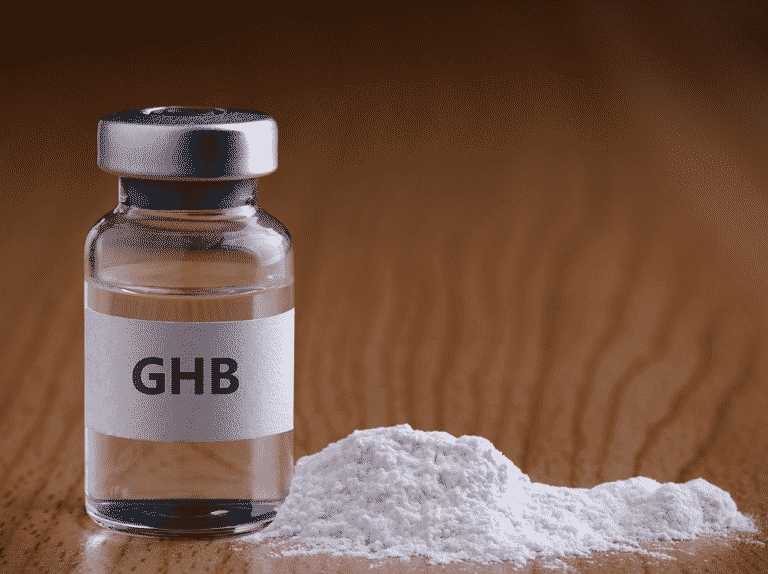GHB is naturally in the body but synthesized has been used as a club drug
GHB (gamma-hydroxybutyrate) is not a newly discovered designer drug; this is a common misconception. It is a natural product of human metabolism — a carbohydrate found in large amounts in our diet. Animal meat contains GHB, so does wine and small citrus fruits. It is also biologically synthesized from GABA (gamma-aminobutyric acid), an amino acid that is structurally like GHB. When made artificially, it is a popular drug among party crowds. It is hard to detect synthetically in the body’s system because it has a short window to test for it.
GHB is called liquid ecstasy
GHB is sometimes called “G” or “liquid ecstasy” and is popular among the party crowd at clubs or raves. It’s used for its euphoric and sedative effects. Combined with alcohol, GHB has become a major “weapon” against people who unintentionally ingest it through unattended drinks. It is also called the “date rape drug.”
Since the mid-90s, recreational use of GHB in the United States has been increasing at a steady pace and made available by underground laboratories.
GHB has no acceptable medical use in the United States; however, has multiple uses in Europe including anesthesia, hypnosis, insomnia treatment, childbirth aid, anxiety suppressant, and to manage opioid withdrawal symptoms.
GHB has no odor or color but has a slight soapy or salty taste. It can be simply combined with alcohol and given to unsuspecting victims before being taken advantage of. It comes in the form of a tablet, capsule, white powder or clear liquid. It looks comparable to water and is typically sold in small vials. It can be snorted, ingested, or injected.
GBH long-term effects: amnesia, cardiovascular collapse, intense anxiety, hallucinations, headaches, mouth sores and infections, muscle pain, poor concentration, respiratory depression, seizures, and slurred speech.
When used regularly, GHB is highly addictive. Acute and debilitating withdrawal effects may include anxiety, insomnia, tremors, and excessive sweating.
There is little information available on treatment options for GHB addiction — the same goes other club drugs. However, the severe withdrawal symptoms upon detox typically require close medical supervision and hospitalization. Memory loss is a common complication of treatment.
History
GHB was synthesized and introduced into medicine in 1960 and in 1963 discovered as a naturally occurring chemical in the human brain. Throughout much of the 1960’s it was a popular anesthetic, but was abandoned by doctors following discoveries of its poor analgesic effects. In the 1970’s, GHB was recommended for the treatment of narcolepsy, though it was also found to be an ineffective and unpopular form of treatment primarily due to its euphoric side effects. Use began to intensify in the 1980’s when it was marketed as a fat burner and muscle developer. However, in 1990, based on more than 30 reports of GHB-linked illness, the FDA declared the chemical unsafe and ordered it to be removed from store’s shelves, thus limiting a user’s ability to purchase the product. Following the FDA ban, many producers of GHB began to switch their ingredients to GBL and BD and sold those drugs as muscle enhancers and sleep aids. On January 21, 1999, the FDA began to ask manufactures of GBL to stop producing it and to recall products containing GBL because it was never approved for human consumption. Around this same time GHB gained in popularity among ‘party drug’ users for its euphoric and aphrodisiac (a substance that enhances sexual desires) effects. In March 2000, GHB was federally classified as a ‘Schedule I’ drug.
Physical Effects
The time it takes GHB to affect a user will depend on whether or not he or she is using GHB in combination with other drugs – especially alcohol and other depressants. Typically, effects are first felt within 10-20 minutes of the initial ingestion; 45 minutes to 1½ hours later effects begin to level off and the user starts to experience decreasing effects. After-effects like grogginess and sleepiness are felt for as little as two hours or up to twelve hours after use. Physical effects of GHB depend heavily on the dose the user has ingested; in other words, each person will have a different response to each dose level, a trait that furthers the dangerous nature of the drug.
Methods of Use
Most illicit GHB is sold in the form of a clear, odorless, nearly tasteless liquid – though it can be somewhat salty tasting. It is often sold or found in a variety of containers such as water bottles, eyedroppers and/or vitamin bottles. Ingestion is usually achieved by mixing the solution with a beverage, usually water or various alcoholic drinks.9 Like other drugs (e.g., ecstasy, marijuana) the chemical composition of GHB is highly variable, and sold in a wide range of concentrations. As a result, there is no definitive way for users to know how strong a particular form of GHB is, thereby increasing the risk of an overdose. Powder forms of GHB are not as prevalent as liquid forms, yet the method of use is nearly identical.
GHB and Date Rape
GHB can be both an odorless, colorless liquid or a white powder. Both forms can be mixed with almost any beverage making it extremely difficult to detect. Because of this people have become victims of date rape after unsuspectingly ingesting GHB slipped into their drinks by an attacker. The effects of GHB – especially when ‘combined with alcohol’ – can induce blackouts and memory loss that allow sexual predators to more easily facilitate sexual encounters.
Save
Save
Save





















